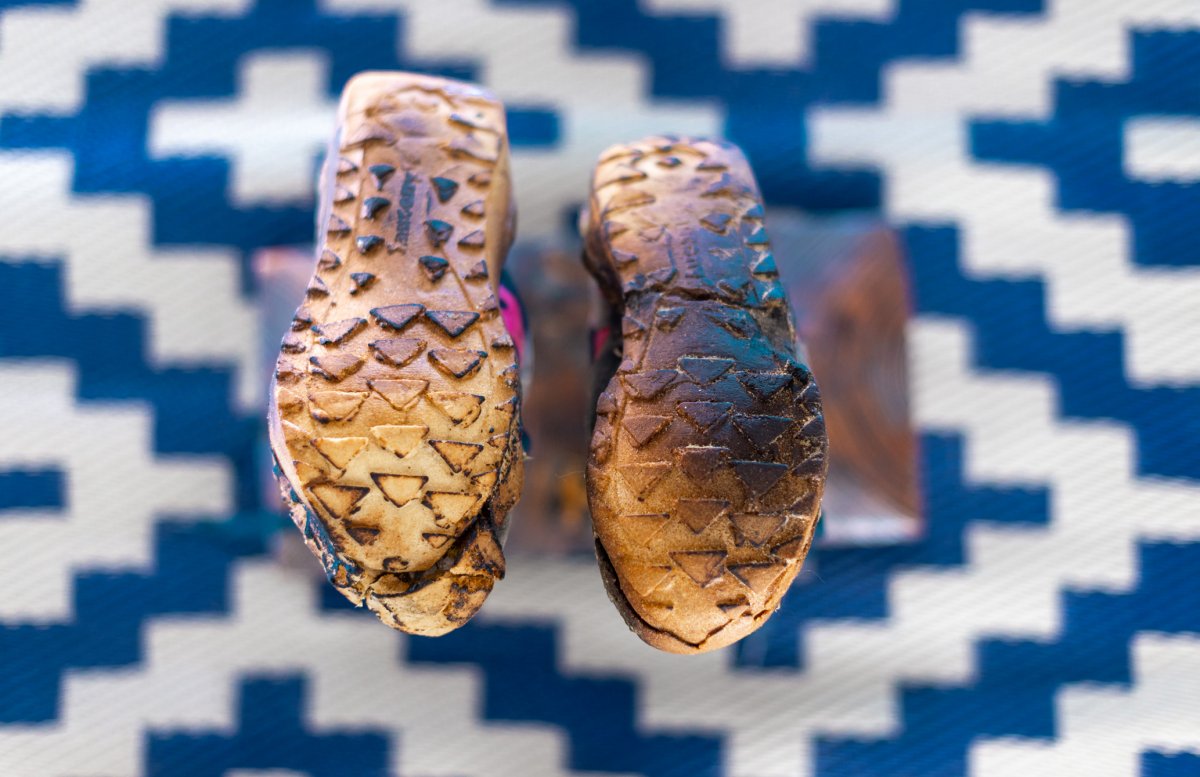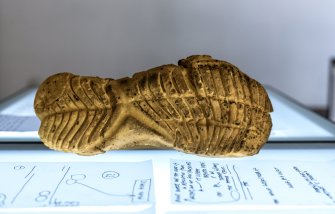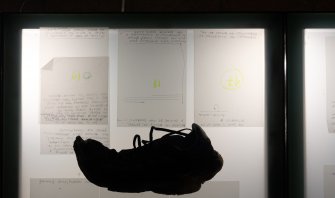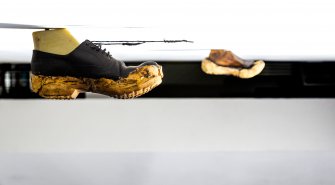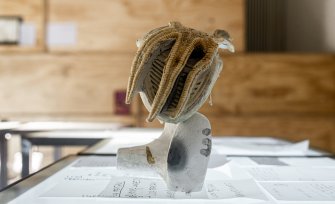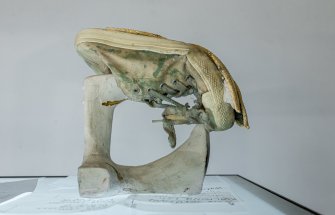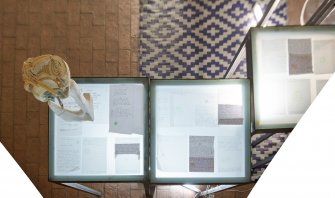Walking loaves
book launch event con Luca Trevisani
Giovedi 30 marzo 2023 alle 19.30 Xing presenta a Raum il nuovo libro di Luca Trevisani, Walking loaves, pubblicato da NERO, con un display set di materiali processuali (centinaia di fogli scritti a mano) e di alcune sculture metamorfiche da indossare, ovvero delle scarpe con suole di pane innestate su tomaie preesistenti.
A Raum Luca Trevisani trasforma un book launch in una proliferazione unica e preziosa. Partendo dall’ipotesi paradossale che un libro possa crescere senza fine, preferisce al rito del firma-copie l'inserzione di modifiche con la sua calligrafia su ogni copia acquistata, proseguendo il processo di scrittura sedimentato sulle pagine già stampate del libro.
Walking loaves è una cannibalizzazione e un omaggio a Il pane selvaggio, il capolavoro del filologo, antropologo e critico letterario italiano Piero Camporesi. Pubblicato originariamente nel 1980, Il pane selvaggio è un libro sul pane come soggetto culturale, sulle pratiche di panificazione e i rituali dell'umanità che siamo stati e sul modo in cui ci nutrivamo. Cercando di cristallizzare nelle sue sculture l'atto del camminare e la metamorfosi del corpo, Luca Trevisani ha dedicato diversi esercizi di calzoleria al pane, enfatizzato come collante collettivo, storia materiale e scrittura biologica. Dopo tre anni di ricerca plastica ed editoriale sul pane, Luca Trevisani rende omaggio a Camporesi, innestando immagini delle sue opere e appunti manoscritti sulla sua replica anastatica: una mutazione cresciuta negli interstizi di un altro libro con un gesto insieme gentile e aggressivo.
Il libro Walking loaves si ricollega all'installazione/performance Ai piedi del pane presentata da Xing all’interno della serie Oplà. Performing Activities, in occasione di Arte Fiera 2022 a Bologna. Il pane per Trevisani è l'oggetto tecnologico più importante della storia. In un gesto di archeologia culturale che sfidava con ironia le gerarchie dei valori materiali, per quel contesto Luca Trevisani aveva realizzato delle scarpe da calzare e attivare, in una sorta di stress test d’autore.
"Se ogni scultura è un concentrato di realtà, così anche l’alimento più basilare come il pane, o la scarpa nella sua funzionalità, sintetizzano storia, cultura, tempo, relazioni sociali." (L.T.)
Luca Trevisani è un artista la cui pratica multidisciplinare è stata esposta a livello internazionale in musei e istituzioni, tra cui MAXXI Roma, Biennale of Sydney, Manifesta 7 Rovereto, Biennale di Architettura di Venezia, MOT Museum of Contemporary Art Tokyo, Kunsthalle Wien, Kunstverein Braunschweig, ZKM Karlsruhe, Magasin Grenoble. Oltre a premi e mostre in importanti centri d’arte e musei ha pubblicato diversi libri tra cui: The effort took ist tools (Argobooks, 2008), Luca Trevisani (Silvana Editoriale, 2009), The art of Folding for young and old (Cura Books, 2012), Water Ikebana (Humboldt Books, 2014), Grand Hotel et des Palmes (NERO Editions, 2015), Via Roma 398. Palermo (Humboldt Books, 2018), Walking loaves (NERO, 2023), e realizzato il documentario di fantascienza Glaucocamaleo (2014). Ha scritto testi e saggi, tra gli altri, sul lavoro di Francesco Lo Savio, Luca Vitone, Giovanni Anceschi, Gianni Colombo, Liam Gillick, Mark Manders. Insegna allo IUAV a Venezia, e presso la Libera Università di Bolzano. La sua ricerca spazia fra la scultura e il video, e attraversa discipline di confine come le arti performative e quelle grafiche, l’architettura e il design, il cinema di ricerca o l’architettura, in una perpetua condizione magnetica e mutante. Nelle sue opere le caratteristiche storiche della scultura sono interrogate se non addirittura sovvertite, in un’incessante indagine sulla materia e sulle narrazioni. La traiettoria della ricerca di Trevisani è quella di un esploratore; un libero pensatore che studia con curiosità – ma anche con distacco – le più diverse ed eclettiche forme del linguaggio plastico, agendole dall’interno pur senza mai ambire a possederle definitivamente, ma piuttosto cercando di svelarne – e se possibile modificarne – la loro microfisica. Conservando sopra ogni altra quell’assoluta passione per l’utilità pratica e sociale del proprio lavoro e per le grandi questioni che esso coltiva, che costituisce forse la vera cifra di chi pratica con autorevolezza la ricerca artistica. www.lucatrevisani.eu lucatrevisanipictures.com
info/acquista: www.neroeditions.com/product/walking-loaves/
***
Thursday 30 March 2023 at 7.30 pm Xing presents at Raum the new book by Luca Trevisani, Walking loaves, published by NERO, with a display set of the process materials (hundreds of handwritten sheets) and a few of his metamorphic sculptures to wear: shoes with soles of bread grafted onto existing uppers, bas reliefs to take for a walk or collect.
At Raum Luca Trevisani transforms the launch of a book into a unique and precious proliferation. Starting from the paradoxical hypothesis that a book can grow without end, he prefers to add new unpublished materials handwritten on each purchased copy, to the ritual of the signature-copy, continuing the writing process settled on the already printed pages of the book.
Walking loaves is a cannibalization of and tribute toBread of Dreams, the masterpiece by Italian philologist, anthropologist, and literary critic Piero Camporesi. Originally published in 1980,Bread of Dreams is a book about bread as a cultural entity, about the baking practices and the rituals of the humans we have been, and the way we used to feed ourselves. Seeking to crystallize in his sculptures the act of walking and the metamorphosis of the body, Luca Trevisani has dedicated several shoemaking exercises to bread—emphasized as a collective glue, material history, and biological writing. After three years of plastic and editorial research on bread, Luca Trevisani pays homage to Camporesi, grafting images of his works and handwritten notes onto its anastatic replica: a mutation grew in the crevices of another book with a gentle-aggressive gesture.
The book Walking loaves is also connected to his installation/performance Ai piedi del pane presented by Xing within the series Oplà. Performing Activities at Arte Fiera 2022 in Bologna. For Trevisani, bread is history’s most important technological object. In an act of cultural archeology that ironically challenged the hierarchies of material values, for that context Luca Trevisani created shoes to put on and activate, in a sort of artistic stress test.
"If each sculpture is a distillate of reality, so does a fundamental food such as bread, or the shoe in its functionality, synthesise history, culture, time, and social relations." (L.T.)
Luca Trevisani is a multidisciplinary artist whose works have been exhibited in museums and institutions throughout the world, including MAXXI in Rome, Biennial of Sydney, Manifesta 7 Rovereto, Biennial of Architectur in Venice, MOT Museum of Contemporary Art in Tokyo, Kunsthalle in Vienna, Kunstverein in Braunschweig, ZKM in Karlsruhe, and Magasin in Grenoble. In addition to awards and shows in major art centres and museums, he has published several books, including: The effort took its tools (Argobooks, 2008), Luca Trevisani (Silvana Editoriale, 2009), The art of Folding for young and old (Cura Books, 2012), Water Ikebana (Humboldt Books, 2014), Grand Hotel et des Palmes (NERO Editions, 2015), Via Roma 398. Palermo (Humboldt Books, 2018), Walking loaves (NERO, 2023), and directed the science-fiction documentary film Glaucocamaleo (2012). He has written texts and essays on the works of artists such as Francesco Lo Savio, Luca Vitone, Giovanni Anceschi, Gianni Colombo, Liam Gillick, and Mark Manders. He teaches at IUAV in Venice and at the Free University of Bolzano. His research ranges between sculpture and video, and crosses borderline disciplines such as performing arts, graphics, design, experimental cinema and architecture, in a perpetual magnetic and mutant condition. In his works the historical characteristics of sculpture are questioned or even subverted, in an incessant investigation of matter and its narratives. Trevisani’s research is that of an explorer: a freethinker who studies the most diverse and eclectic forms of plastic language with curiosity – but also with detachment – acting on them from the inside although never aspiring to possess them definitively, instead seeking to reveal (and, if possible, to modify) their microphysics. Above all, conserving absolute passion for the practical and social utility of his work and for the great questions that it cultivates: perhaps the real significance of someone who conducts artistic research with authority. www.lucatrevisani.eu lucatrevisanipictures.com

